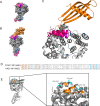Characterization and applications of a Crimean-Congo hemorrhagic fever virus nucleoprotein-specific Affimer: Inhibitory effects in viral replication and development of colorimetric diagnostic tests
- PMID: 32492018
- PMCID: PMC7295242
- DOI: 10.1371/journal.pntd.0008364
Characterization and applications of a Crimean-Congo hemorrhagic fever virus nucleoprotein-specific Affimer: Inhibitory effects in viral replication and development of colorimetric diagnostic tests
Abstract
Crimean-Congo hemorrhagic fever orthonairovirus (CCHFV) is one of the most widespread medically important arboviruses, causing human infections that result in mortality rates of up to 60%. We describe the selection of a high-affinity small protein (Affimer-NP) that binds specifically to the nucleoprotein (NP) of CCHFV. We demonstrate the interference of Affimer-NP in the RNA-binding function of CCHFV NP using fluorescence anisotropy, and its inhibitory effects on CCHFV gene expression in mammalian cells using a mini-genome system. Solution of the crystallographic structure of the complex formed by these two molecules at 2.84 Å resolution revealed the structural basis for this interference, with the Affimer-NP binding site positioned at the critical NP oligomerization interface. Finally, we validate the in vitro application of Affimer-NP for the development of enzyme-linked immunosorbent and lateral flow assays, presenting the first published point-of-care format test able to detect recombinant CCHFV NP in spiked human and animal sera.
Conflict of interest statement
The authors have declared that no competing interests exist.
Figures







Similar articles
-
The Role of Nucleocapsid Protein (NP) in the Immunology of Crimean-Congo Hemorrhagic Fever Virus (CCHFV).Viruses. 2024 Sep 30;16(10):1547. doi: 10.3390/v16101547. Viruses. 2024. PMID: 39459881 Free PMC article. Review.
-
Detection of IgG antibody against Crimean-Congo haemorrhagic fever virus using ELISA with recombinant nucleoprotein antigens from genetically diverse strains.Epidemiol Infect. 2014 Oct;142(10):2147-54. doi: 10.1017/S0950268813002987. Epub 2013 Dec 13. Epidemiol Infect. 2014. PMID: 24330947 Free PMC article.
-
Sensitive and specific detection of Crimean-Congo Hemorrhagic Fever Virus (CCHFV)-Specific IgM and IgG antibodies in human sera using recombinant CCHFV nucleoprotein as antigen in μ-capture and IgG immune complex (IC) ELISA tests.PLoS Negl Trop Dis. 2018 Mar 26;12(3):e0006366. doi: 10.1371/journal.pntd.0006366. eCollection 2018 Mar. PLoS Negl Trop Dis. 2018. PMID: 29579040 Free PMC article.
-
Recombinant nucleoprotein-based enzyme-linked immunosorbent assay for detection of immunoglobulin G antibodies to Crimean-Congo hemorrhagic fever virus.J Clin Microbiol. 2002 May;40(5):1587-91. doi: 10.1128/JCM.40.5.1587-1591.2002. J Clin Microbiol. 2002. PMID: 11980926 Free PMC article.
-
Molecular Insights into Crimean-Congo Hemorrhagic Fever Virus.Viruses. 2016 Apr 21;8(4):106. doi: 10.3390/v8040106. Viruses. 2016. PMID: 27110812 Free PMC article. Review.
Cited by
-
The nucleocapsid protein of Crimean-Congo hemorrhagic fever virus interacts with eIF4A to promote the translation of viral mRNA in cells.J Biol Chem. 2025 Jun;301(6):110173. doi: 10.1016/j.jbc.2025.110173. Epub 2025 May 4. J Biol Chem. 2025. PMID: 40328362 Free PMC article.
-
Development of a Luciferase Immunosorbent Assay for Detecting Crimean-Congo Hemorrhagic Fever Virus IgG Antibodies Based on Nucleoprotein.Viruses. 2024 Dec 28;17(1):32. doi: 10.3390/v17010032. Viruses. 2024. PMID: 39861821 Free PMC article.
-
Development of a novel recombinant ELISA for the detection of Crimean-Congo hemorrhagic fever virus IgG antibodies.Sci Rep. 2021 Mar 15;11(1):5936. doi: 10.1038/s41598-021-85323-1. Sci Rep. 2021. PMID: 33723328 Free PMC article.
-
Exploiting the Affimer platform against influenza A virus.mBio. 2024 Aug 14;15(8):e0180424. doi: 10.1128/mbio.01804-24. Epub 2024 Jul 22. mBio. 2024. PMID: 39037231 Free PMC article.
-
The Role of Nucleocapsid Protein (NP) in the Immunology of Crimean-Congo Hemorrhagic Fever Virus (CCHFV).Viruses. 2024 Sep 30;16(10):1547. doi: 10.3390/v16101547. Viruses. 2024. PMID: 39459881 Free PMC article. Review.
References
-
- Gargili A, Estrada-Peña A, Spengler JR, Lukashev A, Nuttall PA, Bente DA. The role of ticks in the maintenance and transmission of Crimean-Congo hemorrhagic fever virus: A review of published field and laboratory studies. Antiviral Res. 2017;144: 93–119. 10.1016/j.antiviral.2017.05.010 - DOI - PMC - PubMed
Publication types
MeSH terms
Substances
LinkOut - more resources
Full Text Sources
Medical
Miscellaneous

